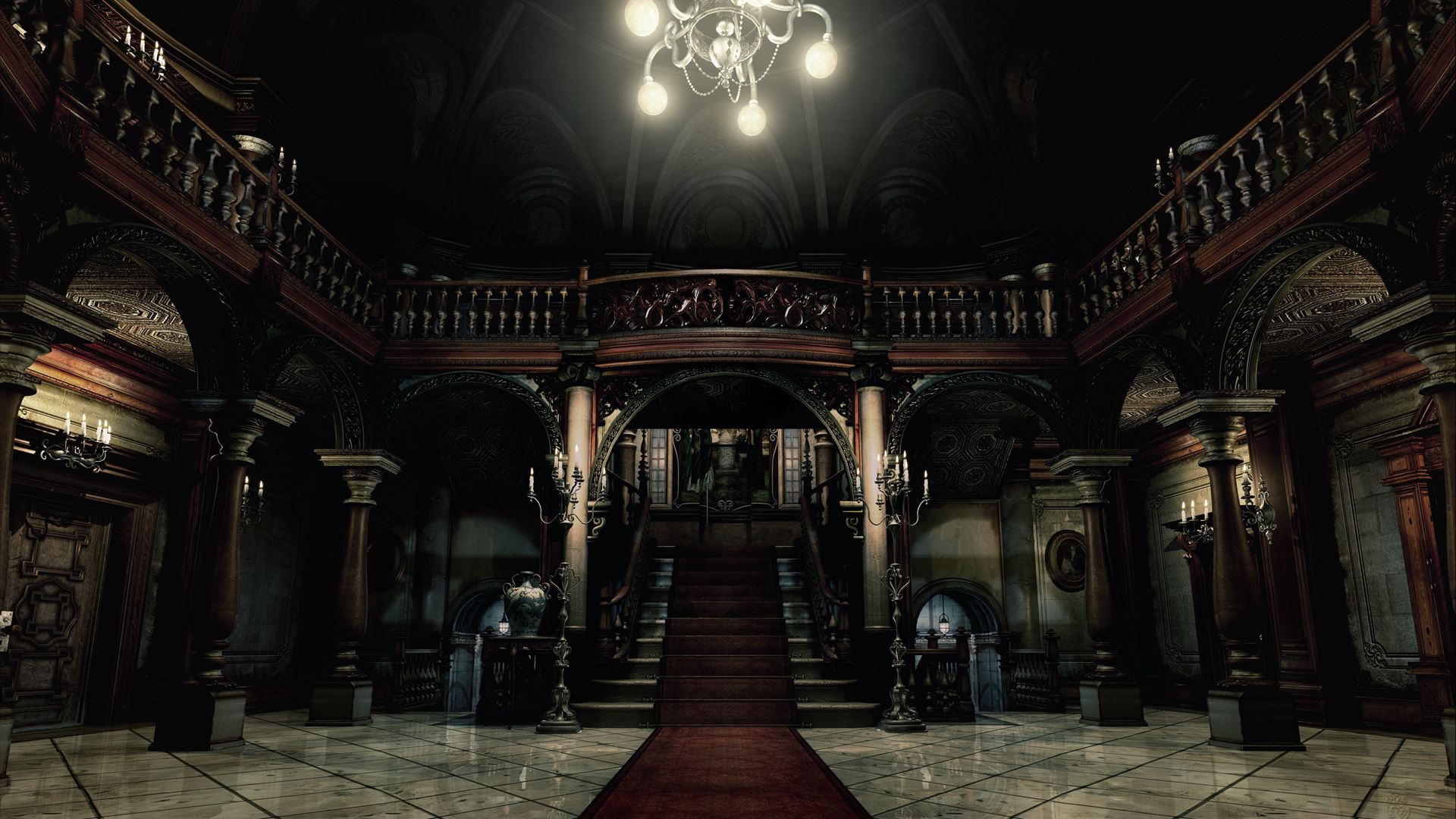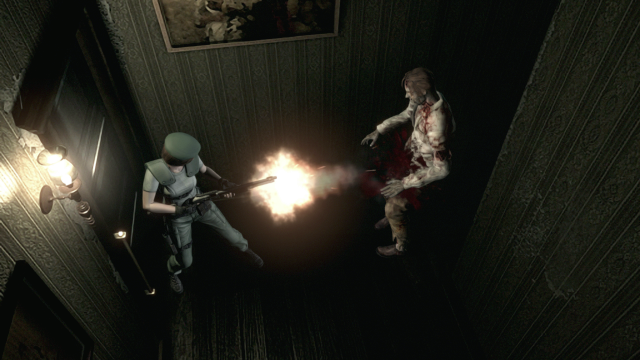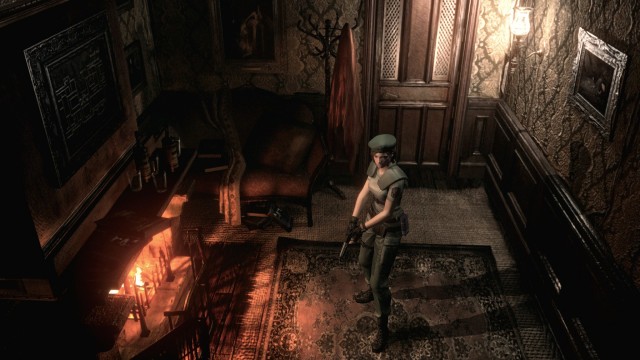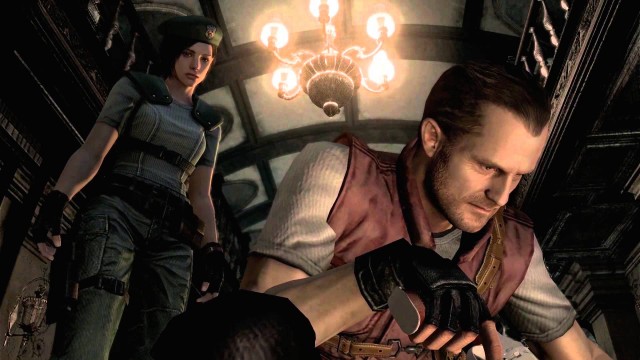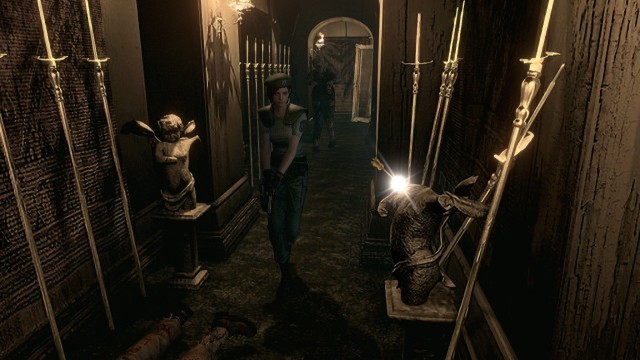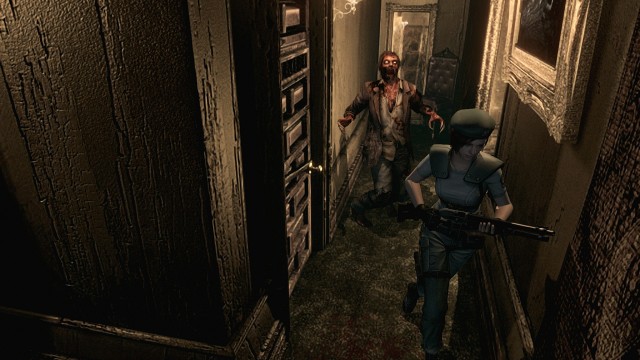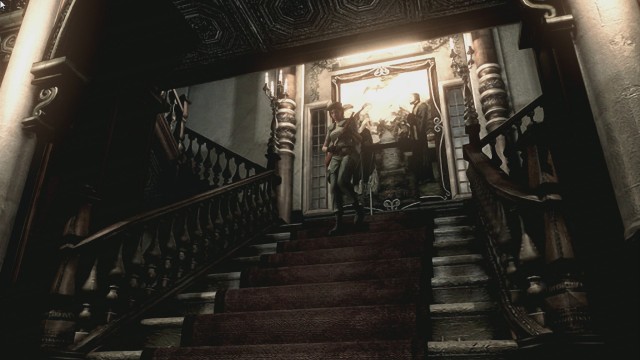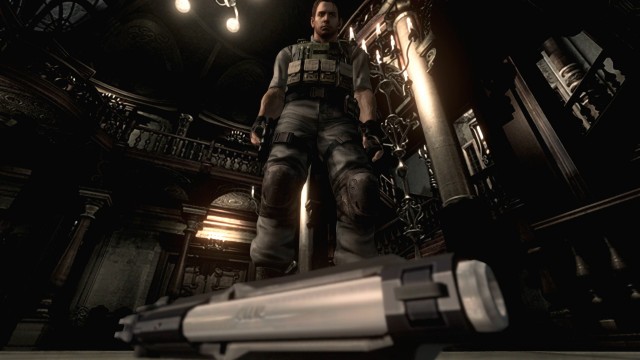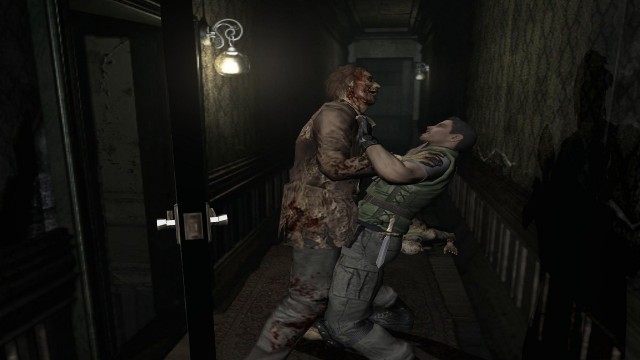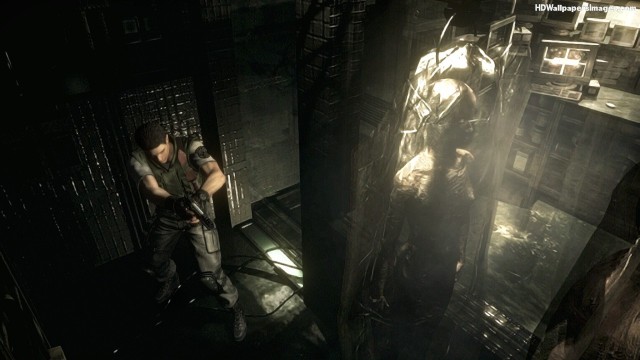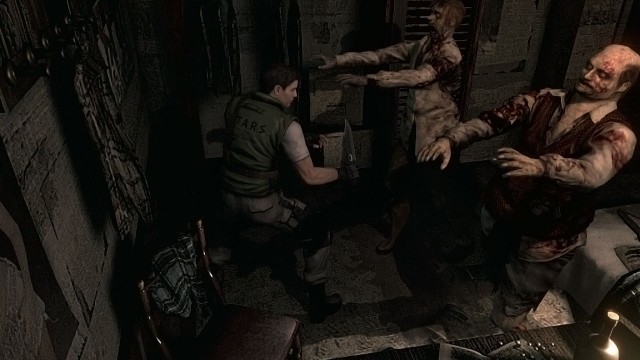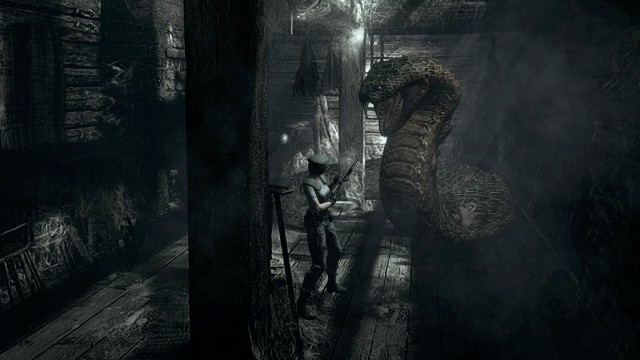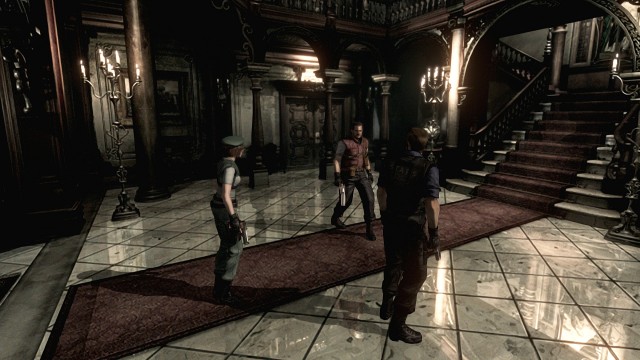Resident Evil represented an incredible turning point for the gaming industry in 1996, when it first hit the original PlayStation. Sure, we laugh at its hilariously bad voice acting and inadvertently cheesy presentation now, but back when it first came out, it not only put the survival-horror genre on the gaming map, but was also one of the earliest console forerunners in the push for modern, cutting edge video games that boasted the immersive production values of Hollywood movies.
This ambition is also what led to a far more seriously-realized and terrifying Nintendo GameCube-exclusive Resident Evil remake in 2002, which has been hailed as one of the console’s overall best games, and one of the scariest games of all time on any platform. Rebuilt from the ground up to take advantage of then-cutting-edge next-gen gaming technology, with all new mechanics, puzzles and foes, Resident Evil 2002 felt like an entirely new experience, even to veterans of the original 1996 release, completely leaving its charming, but heavily dated PlayStation inspiration in the dust. In fact, the only big issue with one of the best remakes in gaming history is that it was only available to Nintendo gamers, with the only subsequent port of the remake dropping on Wii in 2009, and thus leaving PlayStation, Xbox and PC gamers completely out of the fun.
As of this year though, that’s thankfully no longer the case! An all-new HD remaster of the Resident Evil remake has dropped on PC, PS4, Xbox One, Xbox 360, and PS3, at long last expanding the reach of this superb revamp. It not only gives a new HD coat of paint to the game, but also updates the aspect ratio, touches up textures, environments and models, and provides some all-new incentives to chase for dedicated series fans, particularly with the addition of achievements/trophies.
With that said, Resident Evil 2015 is more of an HD re-release than a truly new experience, taking the exact same presentation style, progression and gameplay from the original 2002 GameCube remake, then just making it a bit glossier, and giving it a few new extras. It’s still undeniably got some frustrating elements that are stuck in gaming’s past as well.
Even then though, there’s no denying that Resident Evil’s remake absolutely holds up in 2015, still being a terrifying and humbling trek through a house of deadly horrors, respectable and beautiful in its simple, uncompromising vision of high, fearful tension. Longtime Resident Evil fans, and curious newcomers alike, will find this to be the definitive way to brave the challenging deathtraps and bloodthirsty monsters of Spencer Mansion!
Resident Evil was a visual stunner when it first hit the GameCube in 2002, and it’s a real testament to how gorgeous that game was when you see how well the visuals still stand, barely disturbed in 2015. As disappointing as it is that Resident Evil 2015 doesn’t present another all-new visual overhaul, it sort of doesn’t need to. The visuals already feel polished and breathtaking, with Capcom touching up what’s necessary to bring the game a little more out of 2002.
Environmental textures and lighting effects are where you’ll notice the most upgrades in contrast to the original GameCube/Wii build, and the visual touch-ups given to the environments are universally superb. Character models still look like they belong on the GameCube when scrutinized up close, sadly, though they have also seen some improved animations and a few small touch-ups. Likewise, the in-game cutscenes definitely look sharper on modern platforms, especially with Capcom so effectively crafting a means to view the game in full 16:9 widescreen for this 2015 release, upping the immersion immensely, even if purists can still play in the GameCube’s standard 4:3 ratio if they want. It’s the pre-rendered FMV’s that feel like the biggest reminders that this is a port of a remake from 2002 however, since these are now blurry and janky on all five platforms, clearly suffering on more sophisticated modern machines, and completely unable to escape their GameCube origins.
Really though, it’s more true than ever that Spencer Mansion itself is the real star of Resident Evil 2015. It’s the place that feels more beautiful and immersive than it’s ever been, especially on next-gen hardware. Even purely relying on a cinematic foundation pioneered on the GameCube, the small modern touch-ups are enough to make the scares feel that much more gripping, and the great cinematic cutscenes feel all the more impressive. Even the visual upgrades to the inventory menu are a joy to look at, giving Resident Evil 2015 a great sense of polish, even if it’s still relying on the visual engine of a GameCube game.
If you’re curious about any potential visual divides between the five versions of Resident Evil 2015, there’s actually not too many. The PC version is top dog visually, though only by a bit, despite it being the only version that allows for full 60fps performance on optimal settings, with the console versions all capping at 30fps. The game is designed for 30fps play however, so this isn’t as big of a draw as you would think. You’ll still get a few added environmental touches on optimal PC settings, particularly with light and shadow effects, but the difference between the modest minimum requirements and optimized requirements is pretty small. It’s clear that Resident Evil 2015, despite making a good effort to optimize itself for PC, is still primarily built with consoles in mind, so PC gamers won’t find many unique advantages that actually impact the experience. On that note, be sure to bring a gamepad if you’re playing on PC, since the keyboard controls are not nearly as reliable as the controller that this game is clearly primarily designed for.
Between the next-gen consoles, the PS4 and Xbox One versions both deliver native 1080p resolution, and are nearly indistinguishable from one another. Resident Evil 2015’s performance is a pretty consistent 30fps on both next-gen consoles, though be advised that the PS4 version sometimes has a weird animation hiccup that makes scenes load a second or so late, and character animations sometime skip a frame. It’s not noticeable if you’re not looking, but it’s definitely a visual oddity, especially since it’s unique to the PS4 version. With that said though, the PS4 version is a wee bit sharper-looking in some places, since the Xbox One version’s shading effects seem to be shakier, and environmental detail is just barely muddier in some places on Xbox One. None of this will stick out though, unless you’re actively trying to run the two versions side-by-side, so don’t expect your experience to be visibly impacted on either console.
Predictably, the Xbox 360 and PS3 versions both cap at 720p resolution, and neither seem to have any real visual advantage over the other. Both last-gen builds are predictably not quite as sharp-looking as the PS4, Xbox One and PC versions either, though you’ll still get the same high-quality cinematic horror gaming experience, even if you haven’t yet upgraded your console.
Regardless of your platform of choice however, there’s plenty to enjoy about the visuals of Resident Evil 2015, especially when they unfold in such a treacherous, but eerily inviting environment that still stands as a hallmark of brilliant world design in gaming.
Resident Evil 2015 upgrades the audio to full 5.1 surround on all five platforms, making an already superb audio job on GameCube become all the more potent and terrifying on modern hardware.
The soundtrack of the GameCube remake holds up effortlessly in 2015 as well, even more than the visuals. The unsettling chords and heart-pounding ambiance carefully pick their environments, constantly building up a sense of dread before you inevitably run afoul of more undead mutant horrors. Even then though, many areas of Spencer Mansion are eerily quiet, keeping players on edge as they wonder whether a jump scare is imminent, with ambushes placed here and there throughout the mansion at certain points in the story. This also creates a greater sense of peace and comfort as you reach a Save Room and exhale at the sound of the gentle melody that plays within. The comfort is fleeting, particularly when a zombie is shambling around waiting to munch on you on the other side of the door, but it’s invaluable when the mansion’s challenges inevitably feel like they’re overwhelming you.
Sound effects have received the greatest boost in the 5.1 upgrade, with guns now sounding more powerful, and monsters sounding all the more ravenous and frightening. The squeamish delight of blasting off a zombie’s head is now extra satisfying in its sharpness as well, just as igniting a corpse with the Lighter and some Kerosene results in a cathartic crackle of flames, with the player resting securely in knowing that they’ve prevented the turn of a Crimson Head, the result of a dead zombie that hasn’t been properly disposed of, and a key addition to Resident Evil’s remade build that is alive and well in its 2015 remaster.
Voice acting is the same as it was in the original GameCube build of this remake, and once again, it’s far, far better than the infamous voiceover work from the original 1996 release. It’s still not quite on the level of many modern triple-A voiceover jobs, especially with some of this game’s dialogue still veering a tad on the cheesy side, but it’s a solid voice acting job that manages to hold up. The only odd element of it in the 2015 remaster is that it feels like the voiceover volume wasn’t touched up for the 5.1 upgrade, so character voices will sometimes sound strangely quiet in contrast to the far punchier sound effects, resulting in sound mixing that felt superior in the GameCube build, even if most of the sound has gotten a boost on modern platforms.
Resident Evil as a series has certainly taken some interesting, and potentially ill-advised turns in more recent entries. That’s perhaps why the 2015 remaster of the Resident Evil remake feels so timely. It comes at a time when big triple-A publishers operate under the odd belief that traditional survival-horror is a dying genre, and the Resident Evil brand is facing the most damage it ever has, particularly after the fiasco of Resident Evil 6 in 2012. This makes it high time for a welcome reminder of what made this series so appealing in the first place.
On that note, the return trip to Spencer Mansion is as fantastic as it ever was. Spencer Mansion, as a gaming environment, is a real thing of beauty. Its tight corridors and maze-like, yet strangely believable architecture initially feel overwhelming, with vital resources and essential puzzle objects and keys being spread across roaming, flesh-hungry zombies and other such deadly bio-freaks. After a while of inevitable failure and death however, eventually, players will gradually learn key routes, and clear paths to much-needed Save Rooms and puzzle destinations. As dangerous and terrifying as Spencer Mansion is, there comes a point where it starts to feel like home.
Memorizing the layout and keeping notes on clues and conspicuous environments is essential as well, since you have heavy restrictions on what you can be armed with at any given point, regardless of your choice of character. Resident Evil boasts two player characters, Jill Valentine and Chris Redfield, both of whom present unique campaigns that take them across similar, but slightly different paths of progression, and more importantly, give different constraints to what you can carry. For example, Jill has eight spots in her inventory, shared between weapons, ammo, puzzle objects, keys and healing items alike, while Chris only has six spots. Likewise, Jill can take less damage than Chris before dying, though has heavier firepower, being the only one of the two that can wield a Grenade Launcher. Jill is also the only one of the two that has a Lockpick, allowing her to open doors that require Chris to find separate Old Key items, eating up even more space in his smaller inventory. Chris however fortunately doesn’t require taking up an inventory space to use the Lighter he starts with, which is needed to incinerate dead zombies, whereas Jill must use up an inventory space by finding a Lighter separately.
Inventory management is crucial when playing as Chris especially, though is equally crucial as Jill, since you’ll rarely, if ever have enough room to carry everything you need without hightailing it back to a Save Room to re-arrange your gear, which is conveniently stored and accessible in its entirety at any Save Room’s Storage Box throughout the game, logic and physics be damned. Running back and forth to a Save Room when you encounter a puzzle and realize you have an object in your Storage Box for it is kind of annoying at times, though this continues to keep tension in the game high, particularly if you’re the type of player to try and conserve as much of the game’s precious limited ammo as you can, by dodging zombies when you’re not forced to fight them.
Everything in Resident Evil comes with a consequence, since everything in the game is limited. Bullets can’t be fired willy-nilly, and must be carefully conserved and searched for, lest you find yourself unarmed upon entering a new area of threats. If you get hurt in that scenario, and decide to use a healing item, you may lose that item for when you need it more during a bad situation later in the game as well. Likewise, even saving your game can only be done so many times, as each save consumes an Ink Ribbon item, which is necessary to save your progress at a typewriter. This, paired with the need to manage your inventory very carefully, delivers a humbling need for preparation and responsibility that few games these days bother to challenge players with.
This careful management of resources was already in place in the original 1996 build of Resident Evil, but the remake comes with another twist that I already mentioned; Crimson Heads. Sure, it’s well and good that you manage to kill a zombie, but in this remake, if you just leave dead zombies where they lie, they’ll eventually re-animate into Crimson Heads, fast, vicious and highly aggressive super-zombies that can kill you in a hurry. In order to prevent a dead zombie from becoming a Crimson Head, you must either successfully blast its head off, which is pretty much done at random (though is most likely with the Magnum or Shotgun), or, you must use a Lighter and a Fuel Canteen that can be filled with a limited supply of Kerosene to burn the remains, which can also be done in Jill’s campaign by filling her Grenade Launcher with Incendiary Rounds. Chris won’t have this option, but he does exclusively have the ability to use Flash Grenades, which he can stuff into the mouth of a zombie if he’s grabbed from the front (a function shared by other limited ‘Defense Items’ like Daggers and the Jill-exclusive Taser Battery Packs), then shoot to detonate and destroy the head of said zombie. Just, be sure to do it from a safe distance, as shooting the grenade too closely will damage Chris!
The Crimson Heads will keep players even further on their toes, and were a scary addition to an already great remake. That said however, they put yet more strategic emphasis on making the most of your limited resources. Naturally, one needn’t bother incinerating zombies in areas that they won’t return to, but those within corridors leading to Save Rooms and hub areas will definitely need to be disposed of properly, since that’s where a Crimson Head is most likely to put an unceremonious end to you when you’re most vulnerable. If you decide to risk it, you may be fine, but you may also risk getting killed by a foe you previously disposed of, potentially eliminating lots of progress, since Resident Evil’s Ink Ribbons actively discourage excessive game-saving.
This no doubt creates the impression of a very challenging game, and yes, Resident Evil’s remake is no cakewalk, being significantly more difficult than its original 1996 incarnation. Fortunately, if you found the original GameCube remake too tough, the 2015 remaster comes with adjustable difficulty, allowing you to set it at the normal, very challenging difficulty level of the original GameCube release, or set it to a more forgiving Easy or Very Easy setting, which results in more plentiful items/ammo, and more easily-killed enemies and bosses. Don’t think that this equates to a dumbing down of the game for avid Resident Evil fans seeking a challenge though! The 2015 remaster also comes with unlockable harder difficulty settings, including a ‘Real Survival’ mode that disables shared Storage Box inventory and auto-aiming. There’s even an especially sadistic mode that makes every enemy in the game invisible, putting even the most devout of Resident Evil players to the test!
The increased accessibility of the 2015 remaster is welcome, especially since it doesn’t come at the expense of the challenge that more hardcore fans may be seeking. Resident Evil now accommodates those who want to work their way up to the more challenging default gameplay, while also presenting new avenues of challenge for those who want to push their skills further. Likewise, you can make the experience as modern or conservative as you wish, opting to play with the original ‘tank’ control scheme in 4:3 ratio if you want to fully emulate the old-school style of the GameCube release, or embracing the new 16:9 widescreen ratio, and playing with an appreciated new control scheme that disables the tank movement, now allowing your character to simply automatically run in whichever direction you push the left stick, rather than turning in place with the left and right inputs, then moving forward or backward with up and down inputs, respectively. Don’t think that disabling the old controls cheeses the game though, as the tight spaces and sometimes annoyingly unhelpful camera angles can still make zombies pretty difficult to consistently dodge!
In fact, for all of its great modern concessions, like adjustable difficulty, streamlined controls and some all-new costumes that take after more modern designs of Jill and Chris from later Resident Evil games that followed the GameCube remake, there are some lingering issues with the original game in this remaster that inevitably remain. Chief among these are the fixed camera angles, which abruptly flip around as you navigate, sometimes obscuring enemies that are barely a few feet away, which your character should have been able to see and react to. The fixed camera viewpoints sometimes result in some unfair hits/deaths, since they sometimes rigidly fail to actually give you a sense of environmental awareness that you should have.
Likewise, Resident Evil can require a ton of backtracking, especially with your characters’ very limited inventory space to consider. This is fine, though more recent gamers that aren’t used to open-ended environments like Spencer Mansion might find the backtracking to be very excessive and irritating. A few elements of the game do feel like they waste your time a bit too much, even for longtime fans that have been behind this series since 1996, but thankfully, they’re not too common.
Lastly, while they are optional, the achievements/trophies are very heavily based around playing and replaying the game over, and over, and over, and over again, under different circumstances. Die-hard achievement/trophy hunters may be annoyed by this, since it’s impossible to get the Platinum Trophy or amass every achievement, without replaying the game upwards of five times, minimum, after you initially complete it. Yes, it’s theoretically possible to beat Resident Evil in less than three hours, as its most prestigious speed run achievement/trophy suggests, but the game might have benefited from not placing so much emphasis on continually beating it umpteen times to fully complete it and unlock everything.
With that said however, replaying Resident Evil certainly isn’t an awful proposition. The 2015 release does a great job of spotlighting why Resident Evil is a mostly timeless gameplay experience that doesn’t show its age for the most part. Its gameplay doesn’t really alter the same fundamental gameplay foundation from the original GameCube build of this remake, even if it does add new customization options, but that’s fine. The 2002 release already largely perfected a pivotal survival-horror gaming foundation, and it doesn’t need another update.
The best part about the gameplay of Resident Evil however, is that it represents pure, untainted horror, before this series and genre seemed to wimp out of standing tall with its roots in the triple-A gaming space. It harkens back to a better time for horror in gaming, and it calls for a welcome return to this kind of tense gameplay experience that takes power away from the player, but in all the right ways. For newcomers and veterans alike, Resident Evil’s gameplay remains a brutal gauntlet of terrors, but also a strangely comforting one.
As with the gameplay, the storyline of Resident Evil feels beautiful in its proud embracing of classic horror tropes, in a time before this series became a mess of super-viruses, increasingly impractical mutations, and generally convoluted ridiculousness. By today’s standards, the storyline is pretty rudimentary, but it’s in the clever details and satisfying plot turns that Resident Evil still spins a great yarn for horror enthusiasts.
As with every release of the first Resident Evil, the story unfolds in July 1998, with a series of grisly murders taking place in the Arklay Mountains surrounding fictional burg, Raccoon City. The victims of said murders appear to be eaten, leading to the Bravo Team of special Raccoon City police squadron, S.T.A.R.S., or the Special Tactics and Rescue Service, investigating, and subsequently disappearing. Fearing the worst, the organization next sends S.T.A.R.S. Alpha Team, who find the wrecked remains of Bravo Team’s helicopter in the mountains, but are forced to flee from a pack of flesh-hungry dogs that devour one of their teammates.
Fleeing to a nearby mansion, a group of S.T.A.R.S. members meet in the main hall, varying, depending on whether you chose to play as Chris Redfield or Jill Valentine. As they investigate their mysterious surroundings, they soon learn that the mansion is infested with flesh-eating zombies, and other such mutations, the product of illegal genetic research that spawned the deadly T-Virus, which holds dire implications for the safety of the world. Trapped and forced to survive as they attempt to escape, the S.T.A.R.S. members must simultaneously outlast the horrors of the mansion, while accomplishing their mission, and putting a stop to the sinister research of the evil Umbrella Corporation.
If you’re at all familiar with the series, this is a story that hits a lot of the plot beats you’d be well familiar with at this point. Still, like I said, exploring Spencer Mansion and piecing together the mystery of the game feels nonetheless satisfying, especially for newcomers. Old photos, note scraps, and other such little collectibles help to create an intriguing and rewarding lore for the series, even if that lore has gone in some strange directions since this original game.
Still, there is something satisfying about re-living how it all started. Resident Evil certainly doesn’t present the most complex of horror plots, but it carries some great shocks and twists that still hold up today, even if series veterans would be well familiar with them. That said though, the effectively simple nature of the plot recalls the true splendour of untainted survival-horror, something that the triple-A gaming arm has sadly lost touch with lately. Even if the scale is far smaller than the series’ future games, it’s nonetheless incredibly satisfying to piece together the origins of the struggle against Umbrella again, or perhaps for the first time, when it’s all the better!
Resident Evil’s superb remake feels like a game that only becomes easier to appreciate with age, which is a bit ironic, since its original 1996 build is so evidently dated. Still, as one of the textbook examples of a video game remake done right, Resident Evil is still a standout survival-horror experience in 2015, and is as great as it ever was for its remaster on modern HD platforms.
Occasionally, you’ll run into some dated design that modern publishers would probably be persecuted for implementing in today’s games, but Resident Evil also stands as a welcome reminder of a forgotten genre of game design, to the point where even this very franchise disappointingly forgot it in recent years! There was a time where people worried about Resident Evil growing repetitive and stagnant, but that time is almost something to be missed now, with the series firmly flying off of its rocker in recent installments, and really needing to return to its roots.
If you’re one of those frustrated longtime Resident Evil fans that yearns for that return to better days, than this remaster is for you, even if mainly to challenge yourself by chasing the all-new achievement/trophy roster, beyond the expected tickle that some good nostalgia delivers. If you have yet to experience the delightful, tense scares of Spencer Mansion at all, this remaster is even more for you, as Resident Evil is required playing for any kind of horror enthusiast with a taste for gaming in its remade form, or even just avid gamers that want to play the industry’s best classics. The all-new adjustable difficulty settings in the 2015 remaster also effectively lower the barrier of entry, if you were put off by the previous GameCube release’s high difficulty level.
Overall, whether you already know Spencer Mansion like the back of your hand, or have never set foot in it before, Resident Evil 2015 is a sharply-presented, well-preserved remaster that comes highly recommended for its $19.99 price. This is one house of horrors that has effortlessly stood the test of time!

